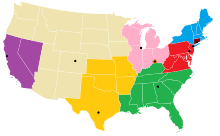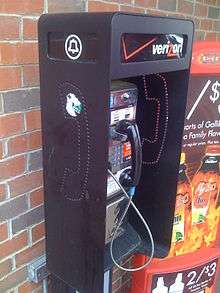Regional Bell Operating Company
The Regional Bell Operating Companies (RBOC) are the result of United States v. AT&T, the U.S. Department of Justice antitrust suit against the former American Telephone & Telegraph Company (later known as AT&T Corp.). On January 8, 1982, AT&T Corp. settled the suit and agreed to divest its local exchange service operating companies. Effective January 1, 1984, AT&T Corp.'s local operations were split into seven independent Regional Bell Operating Companies known as Baby Bells.

RBOCs were originally known as Regional Holding Companies (RHCs). Currently, three companies have the RBOCs as predecessors: AT&T Inc., Verizon, and CenturyLink. Some other companies are holding onto smaller segments of the companies.
Baby Bells
After the Modification of Final Judgment, the resulting Baby Bells were originally named:
Prior to 1984, AT&T Corp. also held investments in two smaller and otherwise independent companies, Cincinnati Bell and Southern New England Telephone (SNET). Following the 1984 breakup, these became fully independent as well. All nine local-exchange holding companies were assigned a share of the rights to the Bell trademark.
Shared trademarks
After divestiture, AT&T Corp. was prohibited from using the Bell name or logo (with the notable exception of AT&T's Bell Laboratories) and those trademarks which would be shared by the RBOCs and the two companies AT&T partially owned. Since the BellSouth acquisition, Cincinnati Bell has been the only former AT&T associated company still carrying the "Bell" name.
Additionally, Bell Canada, the former Bell Telephone Company of Canada (founded in 1880) and which started separating from the Bell System in 1956, and completely by 1975, continues to use the "Bell" trademarks, which it owns outright in Canada.
Verizon continued to use the Bell logo on its payphones (including former GTE payphones), hard hats, trucks, and buildings, likely intending to display continued use in order to maintain the company's trademark rights. Following the company updating its logo in 2015 and subsequent reimaging of its trucks, the Bell logo has since been removed.
Malheur Bell, an autonomous local phone company owned by Qwest, used the Bell name and logo until its merger into Qwest in 2009.
Apart from historical documents, AT&T does not presently make active use of the Bell marks. Its local exchange companies have retained the "Bell" names; however, they have been doing business under other names since 2002. They do maintain web domain names with most of the older Bell names (such as OhioBell.com) which all rollover to the AT&T website. Many of these names are still listed with the US Patent and Trademark Office as current trademarks, since these names are still considered in use.
Mergers
Many of these companies have since merged; by the end of 2000, there were only three of the original Baby Bells left in the United States. After the 1984 breakup, part of AT&T Corp.'s Bell Labs was split off into Bellcore, which would serve as an R&D and standards body for the seven Baby Bells. In 1997, Bellcore was acquired by Science Applications International Corporation where it became a wholly owned subsidiary and was renamed Telcordia.[1]
| AT&T Corporation RBOCs grouped into "Baby Bells" split off in 1984 | |||||||||||||||||||||||||||||||||||||||||||||||||||||||||||||||||||||
| BellSouth | AT&T Corp. (non-LEC) | Ameritech | Pacific Telesis | Southwestern Bell Corp. (later SBC Communications) | Bell Atlantic | NYNEX | US West | ||||||||||||||||||||||||||||||||||||||||||||||||||||||||||||||
| GTE Corporation (non-RBOC ILEC) | Qwest (non-ILEC) | ||||||||||||||||||||||||||||||||||||||||||||||||||||||||||||||||||||
| Verizon | |||||||||||||||||||||||||||||||||||||||||||||||||||||||||||||||||||||
| AT&T Inc. (former SBC) | |||||||||||||||||||||||||||||||||||||||||||||||||||||||||||||||||||||
| CenturyLink (non-RBOC ILEC) | |||||||||||||||||||||||||||||||||||||||||||||||||||||||||||||||||||||
| AT&T Inc. | Verizon | CenturyLink | |||||||||||||||||||||||||||||||||||||||||||||||||||||||||||||||||||
AT&T Inc.
Southwestern Bell Corporation, which changed its name to SBC Communications in 1995, acquired Pacific Telesis in 1997, SNET in 1998, and Ameritech in 1999. In February 2005, SBC announced its plans to acquire former parent company AT&T Corp. for over $16 billion. SBC took on the AT&T name upon merger closure on November 18, 2005. SBC began trading as AT&T Inc. on December 1, 2005, but began re-branding as early as November 21. In 2006 AT&T Inc. purchased BellSouth.[2]
Verizon Communications
In 1997, NYNEX was acquired by Bell Atlantic (taking the Bell Atlantic name), which later, in 2000, acquired GTE, the largest independent telephone company, and renamed itself Verizon.
In 2005, following a protracted bidding war with rival RBOC Qwest, Verizon announced that it would acquire long-distance company MCI. The Verizon and MCI merger closed on January 6, 2006.
CenturyLink
CenturyLink was originally Century Telephone (CenturyTel), and took its current name in 2009 when it acquired Embarq, the former local operations of Sprint Nextel, which also includes the former operations of Centel. The company, as CenturyTel, had acquired some Wisconsin Bell lines from Ameritech in 1998.
CenturyLink announced in April 2010 its intent to buy Qwest for US$10.6 billion.[3] The transaction was completed in April 2011. In August 2011, the Qwest branding was retired and replaced by that of CenturyLink. Qwest, a Denver-based fiber optics long-distance company, had taken over US West in 2000.[4]
Other related companies
Cincinnati Bell
The former independent Bell System franchisee Cincinnati Bell, which was not part of the 1984 divestiture because AT&T held only a minority stake in the company, remains independent of the RBOCs. In December 2019, Cincinnati Bell announced that Brookfield Infrastructure Partners would acquire the company for $2.6 billion.[5]
Consolidated Communications
FairPoint Communications, an independent provider based in North Carolina, acquired Northern New England Telephone Operations. NNETO is an operating company split from the original New England Telephone to serve access lines in Maine and New Hampshire. The sale of these lines by Verizon to FairPoint closed in 2008. Telephone Operating Company of Vermont, a company created following FairPoint's acquisition, was an operating company wholly owned by Northern New England Telephone Operations. In December 2016 FairPoint was purchased by Consolidated Communications, and the combined company operates under the Consolidated Communications name.[6]
Frontier Communications
In 2010, Frontier Communications acquired Frontier West Virginia, one of the original Bell Operating Companies formerly known as the Chesapeake and Potomac Telephone Company of West Virginia, in a larger deal including some former GTE companies with Verizon Communications. In December 2013, AT&T agreed to sell SNET to Frontier, with the sale closing in the second half of 2014.[7]
See also
References
- Dr. J. Robert Beyster with Peter Economy, The SAIC Solution: How We Built an $8 Billion Employee-Owned Technology Company, John Wiley & Sons (2007) p.73
- FCC wrests concessions from AT&T-BellSouth before merger - Dec. 29, 2006. Money.cnn.com (2006-12-29). Retrieved on 2013-09-04.
- DENNIS K. BERMAN; JOANN S. LUBLIN; SPENCER E. ANTE (April 22, 2010). "CenturyTel Buys Qwest in Land-Line Gamble". Wall Street Journal. Retrieved 2010-04-22.
- "Qwest Homepage". Qwest Communications International Inc. Retrieved 2008-01-20.
- Brownfield, Andy (December 23, 2019). "Cincinnati Bell to be acquired for $2.6B". Cincinnati Business Courier. Retrieved January 17, 2020.
- https://www.consolidated.com/fairpoint
- Haar, Dan (December 17, 2013). "AT&T Selling Connecticut Operations To Frontier". Hartford Courant. Retrieved July 15, 2014.
External links
- Pre-divestiture RBOC map (from Bell System Memorial)
- Table of RBOC changes (from Bell System Memorial)
- Note: Does NOT include Verizon spinoffs.
- Bell Operating Companies (from Bell System Memorial)
- Qwest Communications
- AT&T Inc.
- Verizon Communications
- Cincinnati Bell
- Boston.com - FairPoint-Verizon deal comes to a close on Monday

